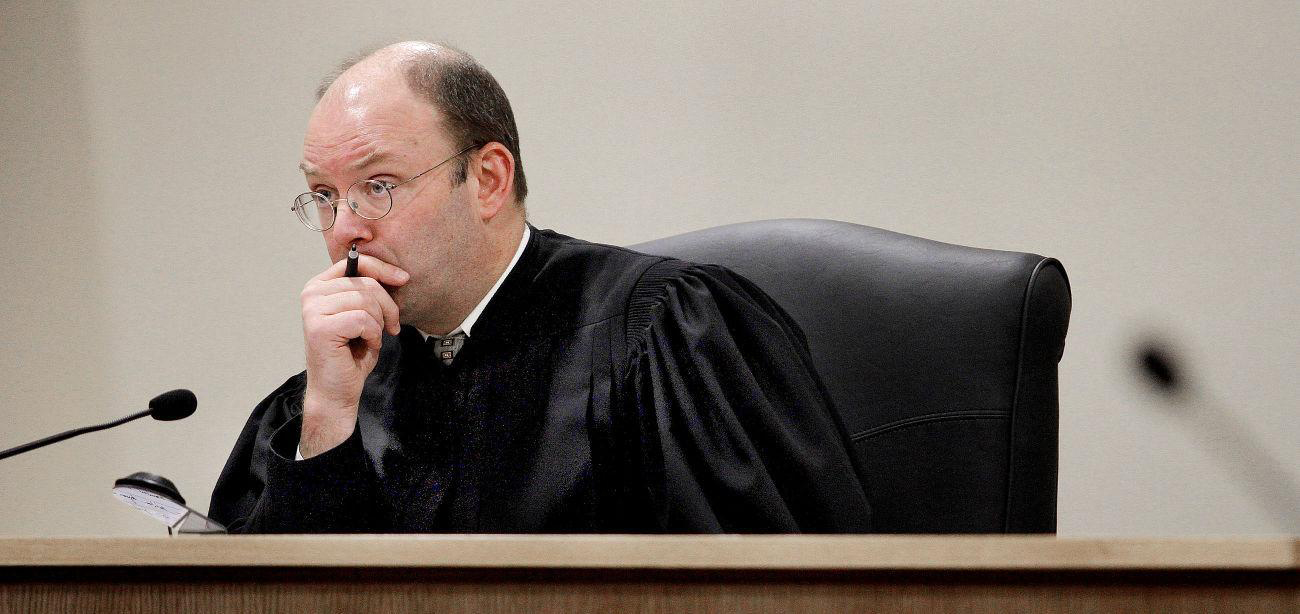Closing arguments focus on cost, responsibility

Judge David Ruoff asked both the plaintiffs and the defense to submit their responses and summary legal statements, indicating that he would need at least a month to review them and issue any opinion. (Courtesy photo)
After three weeks of testimony and argument, the trial pitting the ConVal School District against the state for failing to fulfill its constitutional obligation to fund an adequate education came to a close May 5 in Rockingham County Superior Court, again leaving Judge David Ruoff with a number of thorny issues to resolve.
This was the second time the parties have squared off before Ruoff. The district first filed suit in 2019. Ruoff ruled for the plaintiffs at that time, but he declined to peg the cost of an adequate education, acknowledging that duty rested with the Legislature. Both parties appealed the decision to the state Supreme Court, where the justices, stymied by the outstanding factual questions, chose to remand the case for a full trial.
Michael Tierney, who once taught mathematics at Stevens High School Claremont — the city that lent its name to the landmark school funding litigation of the 1990s — represented the school district, alongside attorney Elizabeth Ewing. He told the court the state Department of Education reported that while the Legislature pegged the base cost of an adequate education at $3,708 and $3,786 per pupil in FYs 2021 and 2022 no district in the state spent less than $15,043, and the average per pupil cost statewide was $19,399.
In the ConVal district, which consists of nine towns, the average per-pupil cost was $24,029, according to the state Department of Education.
Tierney also cited the cost of tuitions paid by the Winchester School District, which sends its high school students to Keene. The per-pupil cost is $14,023, and he said the district could find no alternative for less than $10,000, while some districts charge more than $16,000.
Tierney told the court the state formula applies student-teacher ratios of 25 students to 1 teacher for kindergarten through 2nd grade and 30:1 for grades three through 12, though no district in the state reports a ratio greater than 17.5 students per teacher.
The state also allots $11,728 for teacher benefits, but contributions to the state retirement system, federal employment taxes and health insurance premiums amount to more than $27,000.
According to Tierney, although the state requires schools to have nursing services and all school administrative units to have superintendents — and large ones to employ assistant superintendents and business managers — its funding formula makes no provision for these expenses.
The state also requires schools to provide food service whether profitable or not, said Tierney. In fiscal years 2017 and 2018, schools spent $70.2 million on food service but collected $36.6 million in revenue — half the state’s amount.
Finally, the plaintiffs point out that the funding formula assigns $195 per pupil annually toward the cost of operating and maintaining school facilities, which the Department of Education reported average $1,462 per pupil annually across the state.
In previous testimony, ConVal Superintendent Dr. Kimberly Rizzo-Saunders, one of a number of superintendents and business administrators who testified, concluded that a base adequacy cost of $9,929 is required to meet the state’s obligation.

Michael Tierney
Debating adequacy
Representing the state, Assistant Attorney General Sam Garland made no argument, offered no evidence or called no witnesses to endorse the notion that a constitutionally adequate education can be provided for the cost of $3,786 per pupil.
The strategy prompted Tierney to remark “it can’t be defended because it is indefensible.” Instead, the state staked its defense on two propositions. First, the state refers to the statutes defining the content and addressing the cost of an adequate education.
The content of an adequate education consists of 11 conventional learning areas. As for the cost, the statute prescribes that the Legislature “shall use the definition of the opportunity for an adequate education to determine the resources necessary to provide essential programs, considering educational needs.”
Garland argued that the definition of an adequate education is confined to the learning areas enumerated by statute, along with the minimum standards applying to them, and that the formula for funding an adequate education should not include costs beyond these bounds without the express approval of the Legislature.
“The question is, what does the legislative definition require?” Garland said. He said state law does mandate that school districts provide school buildings, nurses, superintendent services, equipment and supplies, but these components, although required, fall outside the definition of an adequate education, so the state is not responsible for paying for them.
Judge Ruoff acknowledged that what he called “the real world” and the law are at odds. He said the cost of salaries and benefits for teachers — the lion’s share of school district budgets — are set by collective bargaining agreements at the local level. “How is the state to control the cost if it plays no role in that negotiation?” he asked.
The state also contends that the authority to define the content and determine the cost of a constitutionally adequate education is the sole prerogative of the Legislature.
In its brief, the state asserts the court “lacks jurisdiction to award any relief to Plaintiffs other than a simple declaration that the State is, or is not, complying with its constitutional duties.”
Instead, the state argues the means of meeting the state’s constitutional duties is vested in the Legislature, which “possesses the exclusive discretion to determine what programs and what levels of funding are necessary and appropriate.”
“When you start to identify numbers, that’s when you invade the legislative process,” Garland told the court.
Ruoff reminded Garland that, in the Claremont decision of 1993, the Supreme Court ruled an adequate education is a fundamental constitutional right subject to judicial review. And in 2008, the justices expressed their respect for the separation of powers, but added, “The judiciary has a responsibility to ensure that constitutional rights not be hollowed out and, in the absence of action by other branches, a judicial remedy is not only appropriate but essential.”
‘Whose responsibility?’
Prior to the closing arguments, Ruoff posed a number of questions, soliciting written responses from both parties.
First among them, he sought clarification of the “interplay” between the statutes defining the content and addressing the cost of an adequate education.
Ruoff also directed several questions to the role of the Education Department.
For instance, while the state is accountable for ensuring an adequate education, he asked, “How can the state measure the delivery of an adequate education if the Department of Education has not used the input-based school accountability system, or IBAS, mandated by statute?” Likewise, noting that the Legislature relies on the department to set standards, Ruoff asked if the department is obliged to measure the costs arising from any new standards, as well as determine whether the base adequacy amount is sufficient to defray existing costs plus those associated with revised standards.
“Whose responsibility is it, if not the Department of Education’s,” he asked, “to verify whether the new costs are achievable within the existing base adequacy amount?”
Earlier, when Education Commissioner Frank Edelblut testified, he repeatedly said that the responsibility and authority to define and cost the content of an adequate education was vested in the Legislature. The role of the department, he said, is limited to implementing the statutes enacted by the Legislature. He told the court neither he nor his staff had undertaken an analysis to define the content or determine the cost of an adequate education.
At the time, Ruoff questioned Edelblut’s characterization of his responsibilities. “I’m still trying to process if the graduation requirements are the same as a constitutionally adequate education,” the judge said. “I imagine they’re not. I’m trying to find out where that line is.
I imagine the Legislature wanted you to figure it out,” Ruoff remarked.
Ruoff asked both parties to submit their responses to his questions and summary legal statements, indicating that he would need at least a month to review them and issue any opinion.
Meanwhile, Ruoff is scheduled to try a second lawsuit in September that challenges the school-funding system brought by attorneys Andru Volinsky, John Tobin and Natalie Laflamme on behalf of five property taxpayers.
The state contends that the authority to define the content and determine the cost of a constitutionally adequate education is the sole prerogative of the Legislature.